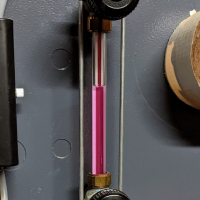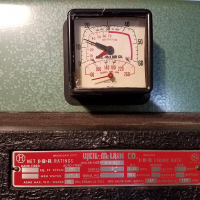Do old radiators lose efficiency?
My understanding is these radiators last forever. Usually when it's cold, it's due to the vent being stuck. But do old radiators tend to be emit less heat due to age?
Comments
-
-
-
-
As mentioned above it depends on whether the radiators are steam or hot water.
Has there been a recent service on the system?
@Ben_Nash....
Also. Did any one check to see if the heating system has been serviced "properly"?
Has there been a heat loss calculation done to check and see if the system is sized properly?
For example.
Proper boiler size, correct radiator sizes, and an EDR measurement if its a steam system?
Is this info on the audit report?
2 -
After you replace the radiator(s) and you still have the same problem, what will you check next?
I believe the energy auditor has no clue. The basic concept of a cast iron radiator can not become more or less efficient with age. That is like saying a gallon of water in an 80 year old 5 gallon pale is not really a gallon. You need a new 5 gallon bucket in order to hold a gallon of water.
CAUTION. OLD BUCKETS HOLD LESS WATER THAT THEY USED TO
Edward Young Retired
After you make that expensive repair and you still have the same problem, What will you check next?
6 -
It's funny to see this come up. One of the recent energy efficiency rebates for Nicor gas is to replace or descale radiators. This sounds awfully fishy. This comes from the specialists that seem to believe there is only a couple percent decrease in fuel usage when going from a commercial atmospheric 80% thermal efficient boiler to a 83% thermal efficient power burner boiler in a typical single boiler space heating aplication.To learn more about this professional, click here to visit their ad in Find A Contractor.3
-
Water heaters, boilers, heat exchangers, tankless water heaters, anything that transfers heat from water to a bare metal.
A coating of scale or rust can limit some heat transfer. Plenty of data out there on. % drop based on build up thickness.
This is true on both the water or fireside of the metal, and fire tube, water tube style boilers, and I would think cast iron vessels, whether they are adding or removing heat energy.
It would be interesting to compare output of a brand new radiator next to a 50 year old one. To see what an IR camera would show. I would guess a low percentage, but certainly some decease of transfer from a scaled or partially plugged boiler.
https://www.awt.org/resources/seed-program/water-careers/science-of-scaling/Bob "hot rod" Rohr
trainer for Caleffi NA
Living the hydronic dream4 -
@hot_rod 's comments on scale would be quire reasonable for hot water heat. Not, however, for steam. Very little scale if any, and remarkably little rust -- which won't make much difference.Br. Jamie, osb
Building superintendent/caretaker, 7200 sq. ft. historic house museum with dependencies in New England6 -
Jamie Hall said:
@hot_rod 's comments on scale would be quire reasonable for hot water heat. Not, however, for steam. Very little scale if any, and remarkably little rust -- which won't make much difference.
Yeah,
Distilled water tends to not carry minerals with it due to it being distilled.
Single pipe quasi-vapor system. Typical operating pressure 0.14 - 0.43 oz. EcoSteam ES-20 Advanced Control for Residential Steam boilers. Rectorseal Steamaster water treatment2 -
I think everyone is making great points about efficiency of old cast iron radiators. I don't believe they lose much of anything due to wear, dirt however is a different story. I had a problem job where was 2 5' radiators in the living room. First call it was the right hand radiator not heating. 10' away the one on the left was freaking hot. This was an old steam system that was converted to HW right after WW2... the big one. The guy had a lot of history on the house.
I went in the basement found all the branch lines. I found both radiators shared the same return. Like it may have been an after thought and they didn't want to cut in a tee into the huge steam line.
I decided to cut above the tee that connected the radiators on the return. I knew I was heading in the right direction when my porta band started throwing black crap during cutting.
Long story short, the 3/4" return was plugged with black crud, just above the connecting tee. We flushed the radiator, Blew out the 3/4 return that was clogged and put everything back together. It worked like a charm... still does.
My point is, it may not be radiator efficiency issue. It could very possibly be the near radiator piping.3 -
Good point @Mustangman, but the radiator is not the inefficient thing. The crud in the piping was the “inefficient thing”. So a replacement radiator with the cruddy pipe would still have a problem heating the room. Hence my Question “After you replace that expensive part, What will you check next?
However if that inspector IS correct, my information may be flawed. Since I am in my 60s that would by default make my repair ideas inefficient. But I still think my ideas would be better than @Jamie Hall 's advise, he is way older than me!
Edward Young Retired
After you make that expensive repair and you still have the same problem, What will you check next?
5 -
Older doesn't necessarily make wiser, @EdTheHeaterMan !Br. Jamie, osb
Building superintendent/caretaker, 7200 sq. ft. historic house museum with dependencies in New England4 -
There is an agree, disagree, like, but where is the "RUDE" button??? 🤣🤣🤣Jamie Hall said:Older doesn't necessarily make wiser, @EdTheHeaterMan !
2 -
I’d liken a cast iron radiator to an iron air purger. They both create a low velocity zone to separate air, but also particles of debris.
Typically flow in hydronic piping is between 2-4fps, probably higher in systems that have had pump/ circulator/ booster upgrades from Series 100’s. So the purger, or radiator becomes an area where debris will settle out.
Also the hotter you run a chunk of steel or iron, the more the minerals in the water come out and adhere to the metal.
There are cleaners made for hydronic and steam systems to keep the heat transfer systems clean and efficient .
I’ve flushed and power washed this old radiator 10 times, or more and still it manages to burp out rust and particles.
I would suggest both hydronic and steam radiators, and boilers drop efficiency over the years due to rust, corrosion, scaling. How much would be a harder number to pinpointBob "hot rod" Rohr
trainer for Caleffi NA
Living the hydronic dream0 -
And yet with steam as long as the radiators are oversized, and most are, rust etc will not lower the efficiency of the system because it'll just cause more of the radiator to heat for the same output. So steam consumption doesn't change just the amount of radiator that gets heated.
That said, @hot_rod my steam radiators feel pretty hot. I wouldn't be surprised if any area exposed to steam is at 212f.
Single pipe quasi-vapor system. Typical operating pressure 0.14 - 0.43 oz. EcoSteam ES-20 Advanced Control for Residential Steam boilers. Rectorseal Steamaster water treatment2 -
YES... the LOL button. We all have a good time here. And we all take the jokes with a grain of salt. I am not in the least insulted by @Jamie Hall's insinuation that I am young and inexperience.Neild5 said:
There is an agree, disagree, like, but where is the "RUDE" button??? 🤣🤣🤣Jamie Hall said:Older doesn't necessarily make wiser, @EdTheHeaterMan !
Edward Young Retired
After you make that expensive repair and you still have the same problem, What will you check next?
3 -
And what I meant was... I may be older than @EdTheHeaterMan but I'm certainly no wiser!Br. Jamie, osb
Building superintendent/caretaker, 7200 sq. ft. historic house museum with dependencies in New England2 -
Disagree!Jamie Hall said:And what I meant was... I may be older than @EdTheHeaterMan but I'm certainly no wiser!
Edward Young Retired
After you make that expensive repair and you still have the same problem, What will you check next?
1 -
A lack of heat from any type of radiator could be a sign that magnetite has settled in the bottom and is causing heat transfer issues. Magnetite (black water / sludge) settles in low flow areas and radiators seem to be the most common place for it to settle.
Specifically in a panel rad, the magnetite builds up in a pyramid in the middle section of the radiator, causing the water to flow over the top of the radiator instead, which affects heat output from the majority of the radiator. This could be why the radiators aren't getting hot or homeowner complaining of particular rooms not heating up.
I recommend testing for magnetite and potential cleaning and flushing the system with a cleaner and magnetic filter.0 -
While I agree with use of magnetic filters, Magnetite is present in any hydronics system where ferrous metal are present. While it can degrade performance of ECM circulators, it typically has little to no impact on system performance.Re the black water in old systems, I’ve heard it called “boiler gold”
 2
2 -
-
I think efficiency applies more to the boiler than it does to the radiators. Scale in the radiators may slow down the heat transfer, but so does the hundreds of pounds of water and cast iron you are trying to heat. No Btu's are really lost. But in a boiler, if the transfer of Btu's to the water is delayed, the unused Btu's will happily float out the chimney.
There was an error rendering this rich post.
1 -
I just finished the overhaul of a 1910 Snowman steam boiler. The header pipes (four of about 5ft long and the horizontal header pipe coming into the boiler were almost completely blocked with sludge; magnetite. At the inlet to the boiler the 1-1/4 pipe ID was down to about the size of a pinky finger due to sludge. However, on the second floor the radiators were clean as a whistle! The gunk occurs with water standing in pipes within five feet leading to the boiler where the magnetite can settle out and accumulate. Upgraded to a new Pressuretrol,a new LWCO,



a new modern 175k BTU gas valve with slow-start ignition to eliminate the "boom" when the burner comes on, insulated pipes, and now the boiler runs at +-0.5PSI and maxes out at 0.7. Note the Pressuretrol is set at 2PSI and NEVER even kicks in. However, there is a plan to install a V


aporstat to reduce the boiler cycling. The boiler is so well matched to the house that an equilibrium is established. Before cleaning and replacing pipes, it was shutting down at 2PSI. To all those who say these old boilers are junk and we need a new sheet metal enclosed steam boiler; forget it! We saved about $8,000 by cleaning and overhauling the Arco Snowman. Note inside the valve of the steam radiator is a modulator. If this comes loose from deterioration, it will rotate and BLOCK steam flow! remove the valve stem and rotate it back into position; good as new. Also we added an alarm to the unused NO contacts of the LWCO so the alarm sounds when there is low water, an indicator for the thermostat on, an indicator for the 24VAC power on, and of course a burner power shut-off switch! ToDo; add more rockwool insulation! With this overhaul, the boiler will probably run another fifty years! And the whole system makes almost NO NOISE!8 -
Thank you for the story on this system and your "interventions". I love it when I see these old systems being retrofitted or updated. The steam and boiler companies (HVAC) here in Chicago look at such systems and say: time for something brand new! And these new systems go for 5-15 years before they are replaced . . . again. I live in a neighborhood built in the 20's . . . . there are still a couple of "converted" boilers (coal to gas) . . . but not for long. Essentially, the companies refuse to work on them. How can a homeowner argue?0
-
Cast Iron Steam radiators that were converted to hot water do muck up and restrict and/or stop flow.
On monoflow systems I've back-washed a few of them clean to get them working again.0 -
The first question I ask investigating inadequate heating problems, is how is the heat in other rooms or apartments. In homes and multiple dwellings, heating complaints often are due to excessive cold air infiltration. Other problems can be steam valves and stuck air vents. A radiator can become clogged with scale, which can be flushed out.0
-
I am a physicist, not an HVAC person, but I have really enjoyed reading this discussion. I would suggest that scale and rust on the inside of a radiator might reduce the heat transferred - from the water/steam to the air - within a given amount of time; however, all the heat in the system will eventually be transferred to the room air. That may be a plus in terms of comfort ( fewer but longer and slower heating cycles ). For a gravity run hot water boiler, there is no additional cost. The boiler might fire an extra cycle or two before the thermostat shuts the system off, but there will be a longer period of time between heating cycles… leveling things out in terms of overall heating costs. If the hot water is pushed through the system by an electric pump, then this slower release of heat into the room will result in a small heating cost increase.
The heat has to go somewhere! It gets conducted from the water/steam to the metal radiator, and then gets transferred from the metal radiator to the room air by both radiation and air convection. A small amount of heat will remain in the water and the radiator when the water, radiator, and room air all reach the same elevated temperature ( thermal equilibrium ) which is a few degrees higher than the temperature when the thermostat turned the system on. That last bit of heat will eventually get transferred as the room cools back down to the temperature at which the thermostat starts the cycle again.2 -
Being older than Ed and younger than Jamie and a home owner that has learned a great deal about heating with Anthracite Coal, open to air expansion tanks-which I wish I still had 47 years later and the same simplicity with a steel compression tank and having grown up on beautiful steam heat in my early years and having to live with scorched air

 -COUGH, HACK, WHEEZE, I am of the opinion a top fed dry steam system with a double drop header is the best-no I am not being a snob, honest.
-COUGH, HACK, WHEEZE, I am of the opinion a top fed dry steam system with a double drop header is the best-no I am not being a snob, honest.
Would plumbing code frown on plumbing in capped 15 degree elbows on the bottom of the risers to allow a plumber to push a boiler brush to the point where it stops to break up the rust in a new system if a double drop header is not used?0 -
A minor objection here... words matter (I've said that before).
Crud, dirt, scale, cat hair, what have you has no effect on the efficiency of a radiator. None. Zilch. What it does effect is heat transfer. Any of those can affect the heat output of a radiator -- but the efficiency doesn't change.
Efficiency is defined simply as power output divided by power input. A grubby radiator sends less power into the space, true -- but it doesn't take as much power from the input fluid.
So... old or grubby radiators can lose power output or heating output. But not efficiency.Br. Jamie, osb
Building superintendent/caretaker, 7200 sq. ft. historic house museum with dependencies in New England3 -
@Chrisj,
knowing what I know now, I would have never let them remove my open to air saddle expansion tank which had worked effortlessly prior to the installation of my wood and coal boiler and I never, never, never, would have changed out my 1953 AVCO LYCOMING boiler in 1988 because the plumber told me it was leaking-which it was not, I found out later.
1 -
Heat output for water heating is proportional to (flow X delta T)
If the heat tranfer at the radiator diminishes and if flow remains the same, shouldn't we see a drop of delta T ?
Which means a lower heat output at the radiator.
This must be compensated by longer or more frequent cycles if the water temperature remains the same at the boiler exit.
The boiler sees a hotter return. Effect on efficiency?
So it seems counter-intuitive but the water would need more time spent in the radiator to transfer its BTUs to the air.
So there is probably an other optimum (flow X delta T) for a scaled radiator then for a clean one.
1 -
Well, the basic equation certainly is right. However, the heat output of the radiator will depend on its area, the surface temperature of the radiator. Normally we think of that is quite high -- simply metal -- and we cheerfully state that the surface temperature of the radiator is the same as the water. But... if there is an insulating layer of crud or scale or what have you, it won't be. It will be lower and so, correspondingly, will the heat output.
Which for a given flow translates into a smaller delta T.
Time spent in the radiator -- or anything else -- has no effect other than the impact on delta T.
Now reduced radiator output will translate into warmer water returning to the boiler, and hence less average boiler output being required, which translates into shorter cycles or, in a modulating boiler, may translate into a lower firing rate depending on the control logic.Br. Jamie, osb
Building superintendent/caretaker, 7200 sq. ft. historic house museum with dependencies in New England0 -
Efficiency is the wrong metric. In a hydronic system, 100% of the heat lost goes into heating the building.
The output of a radiator can drop -- with the same water flow, at the same incomeing temperature, it can put out less heat. Or the piping can get blocked and you don't have the same water flow.
The output dropping is only a problem if you have multiple radiators on one zone, and you get underheating of part of the zone because the radiator there has reduced output. Alternately, if the output of the radiator is so reduced that when the zone valve is on 100% of the time the radiator can't meet the heating load of the zone, that's a problem too.
Traditionally radiators were way oversized -- 200% to 300% of the actual load is typical. So a small reduction in output isn't a problem.0 -
If the layers of paint on the outside affect the heat transfer, the same would hold true for scale build up inside. It has a r-value I’d expect, unless the build up is metallic with the same specific heat as the radiator metal.
I can’t imagine it amounts to much until the point of blocking the flow passageways.Bob "hot rod" Rohr
trainer for Caleffi NA
Living the hydronic dream1 -
Efficiency and maintenance are not the same. Also, the older I get the more everything seems colder. I think it's my body, not the radiator, that is losing it's ability to make enough heat. Of course, not enough heat just means it's time for discovery. Old pipes inside are like old people on the outside, the older we get the more wrinkled we become. And sometimes we leak.
 4
4 -
This! I've never seen an unmolested steam system which wasn't generously oversize. Even the one where the owners removed many radiators in the 1970s was still twice what it needed to be, just very uneven.DCContrarian said:.....Traditionally radiators were way oversized -- 200% to 300% of the actual load ...
It is like the Dead Men KNEW there would be rust/dirt/crap, and oversized to allow for it.
0 -
True... sort of. But it's wise to verify. The system Cedric powers, for example, is only about 10% oversize in some conditions...Br. Jamie, osb
Building superintendent/caretaker, 7200 sq. ft. historic house museum with dependencies in New England0 -
Yes, and in my home built in 1890 I see no significant evidence of oversizing of the radiation. In fact with coal burning fireplaces in every major room and jacket vents from the fireplaces in the upstairs rooms it is as though the steam system was designed assuming the more traditional heat was there at least to complement when needed.0
-
Categories
- All Categories
- 85.7K THE MAIN WALL
- 3K A-C, Heat Pumps & Refrigeration
- 49 Biomass
- 418 Carbon Monoxide Awareness
- 72 Chimneys & Flues
- 1.9K Domestic Hot Water
- 5.2K Gas Heating
- 92 Geothermal
- 160 Indoor-Air Quality
- 3.2K Oil Heating
- 59 Pipe Deterioration
- 848 Plumbing
- 5.8K Radiant Heating
- 371 Solar
- 14.5K Strictly Steam
- 3.2K Thermostats and Controls
- 50 Water Quality
- 38 Industry Classes
- 47 Job Opportunities
- 15 Recall Announcements


















